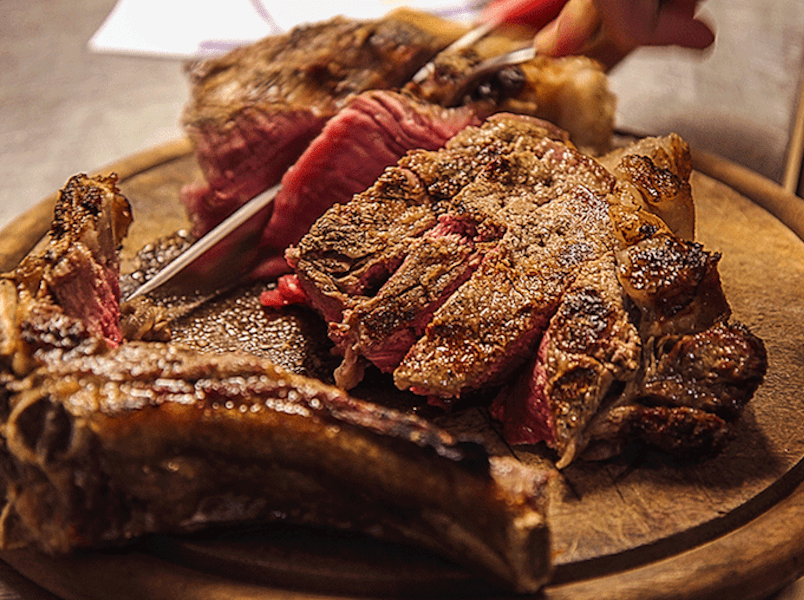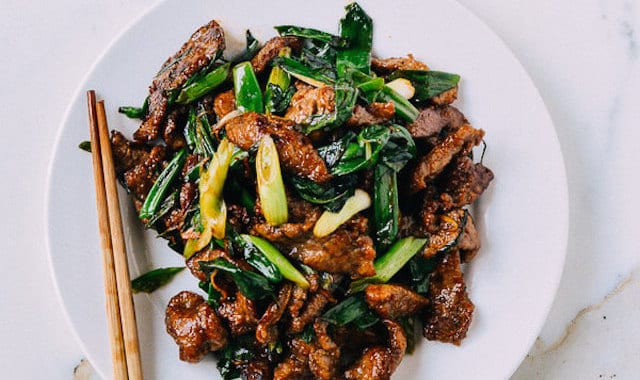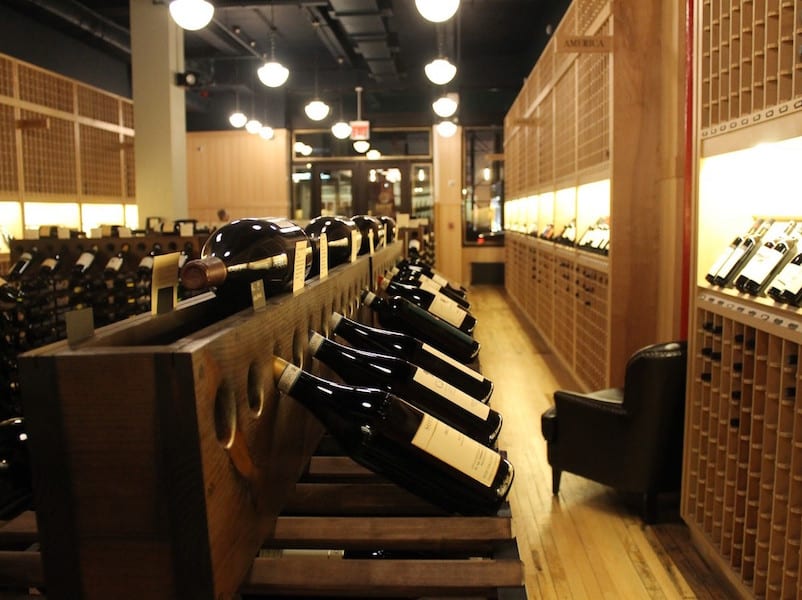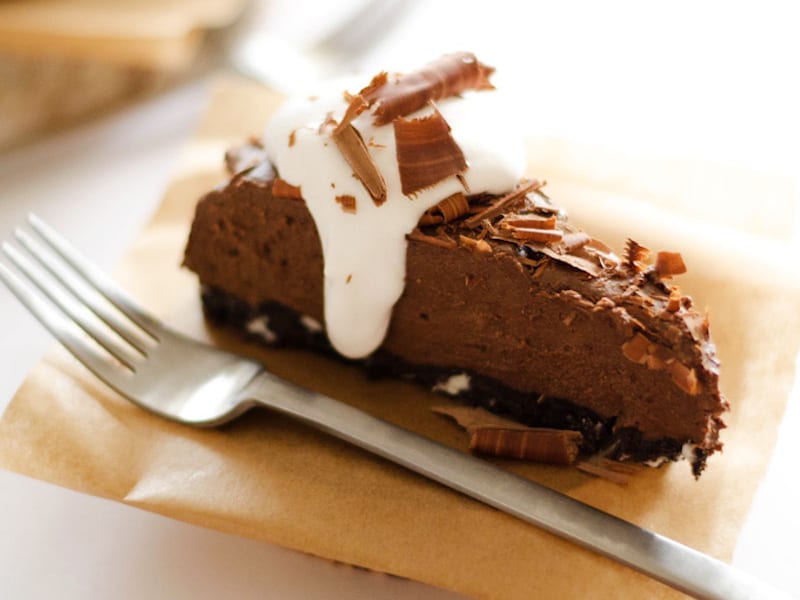Born and raised in Bologna, Italy (hometown of lasagna and…
Learn the history of the tender Florentine steak, where to enjoy it in the region, and how to cook it at home. Grab some friends and dig in.
The Florentine T-bone steak (called Bistecca alla Fiorentina or simply La Bistecca) is a serious matter in Florence. The Tuscan cuisine has plenty of delicious dishes, but if you must choose only one of them, as your last meal, opt for la Bistecca!

Florence, Tuscany; The night of San Lorenzo, August 10, sometimes in the XVI Century. That is the night of the shooting stars, symbolizing in the popular imagination the hot coals on which the Holy man was martyred. Large braziers have been placed around the Church of San Lorenzo. Huge quarters of beef are cooking slowly over the braziers. The Florentine people are sitting on benches, on the steps in front of the church, around the fire, eating voraciously large portions of meat, while butchers improvised cooks keep going to roast and slice more cattles ready to be mauled. Florence in the ‘500 is rich and booming. The De’ Medici’s family rules the city with a firm hand and bright intuition; The banking system, invented and managed by this great Florentine family, brings into the city Lords and rich merchants from all over Europe. Right here history and legend intertwine together; A group of rich British, attracted by the pantagruelian feast set up between the fires of San Lorenzo, sits next to the populace and bite the slices of meat with their noble teeth.”Beff steak! Beef steak!” Scream the English nobles still asking for more meat. From this hungry cry – beef steak! – was born the Italianate term of the most famous Tuscan dish in the world: the Bistecca.
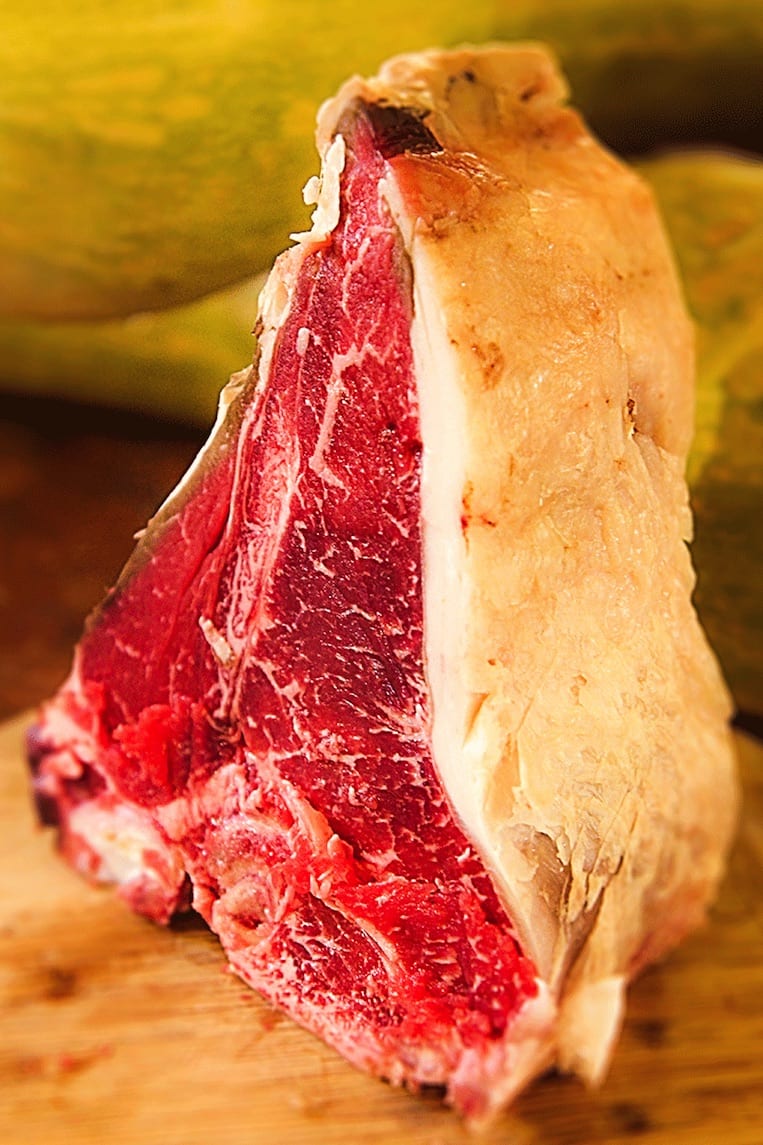
CUTTING AND PREPARATION
The Florentine Steak is a cut of meat made from the part of the loin near the leg of the Scottona (young female bovine never get pregnant, aged 15/16 months). The cut of the Florentine steak must absolutely include a “T” bone between the sirloin and the tenderloin, otherwise is called Costata (only Sirloin with bone) and is derived exclusively from the part of the loin near the shoulder.
Because the meat is tender and tasty must be well marbled, for this reason, the cattle must have the characteristics of the Scottona. Even the hanging has a key role to ensure the flavor and softness; the whole loin must be hanged for a time varying between 15 and 21 days before cutting.
The cut of Florentine Steak in Tuscany is an ancient art; The minimum thickness for a Florentine Steak worthy of its name is of 1.5 inch, but the perfect cut is not less than 2/2.5 inches. The weight ranges from 1.5 lb to 4lb, but my favorite cut weighs 3 lb, a nice feast to share with friends!
BREED CHOICE: CHIANINA OR NOT CHIANINA?
Several people in Italy think that the only breed apt to obtain a traditional Florentine Steak is the Chianina. This is only partly; although the Chianina produce a meat of excellent quality, many Tuscan butchers prefer other national races. Dario Cecchini, the most famous Italian butcher, serving in his butcher shop/restaurant in Panzano, an excellent Florentine steak produced by Spanish cattle!
WHERE TO EAT THE FLORENTINE STEAK IN FLORENCE
In Florence, all the city’s restaurants serve the T-bone Florentine Steak, but sometimes the results are hit-or-miss. To make no mistake I recommend some historic restaurants, that prepare and cook “the Queen of the meats” following the tradition. Among these, I suggest the “Trattoria Mario” near the Central Market, “I’Brindellone” in San Frediano and Perseus near Piazza dellla Libertà. In my recent trip in Florence (click here to read my travel guide) I ate a Terrific Florentine Steak at “Antico Ristoro di’ Cambi”, in San Frediano and would highly recommend a visit!
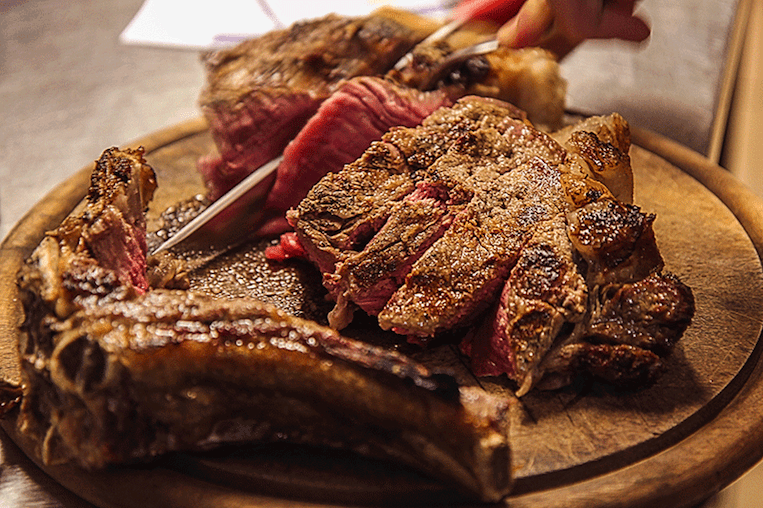
COOKING AND PRESENTATION
Here are a few tips to know if a restaurant is properly serving the Florentine steak: 1) The restaurant should give you the option to choose the peice of meat before cooking 2) The cook does not have to give you the opportunity to choose the level of cooking, the Florentine Steak must be cooked and eaten in only one way: rare!
In the past, the Florentine Steak was cooked on the embers. Currently, especially in cities, the health rules make it very difficult to proceed with this type of cooking. Cooking Florentine Steak begins standing on the basis of the bone on the hot grill for about 15 minutes; In this way, the bone will transmit heat to the meat without cooking it, relaxing the fat fibers. Once the interior of the steak is warm, it is placed on high heat cooking 5 to 7 minutes on each side, depending on the thickness. The steak should be turned only once and must be distinctly marked by the grill. The salting of meat should be carried out only after cooking, possibly with cooking salt that will enhance the flavor of the meat without attacking too much ( while you eat the steak, discard the salt!). Before you can eat it, Florentine Steak must rest between 10 and 15 minutes in a warm environment (such as a heated oven and then turned off) to allow redistribution of the juices.
Whether You decide to enjoy the Bistecca alla Fiorentina in Florence or in the surrounding countryside, due to the large amount of meat, share the experience with your friends! To fully enjoy the steak you can not miss a nice bottle of Chianti red wine and a few typical Tuscan sides, like roasted garlic potatoes, spinach with Pecorino cheese or Cannellini beans.
If you want to try cooking the Florentine Steak at home, you can find below all the instructions.
Print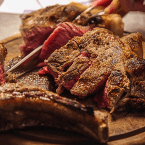
5 Stars 4 Stars 3 Stars 2 Stars 1 Star
No reviews
- Author: Filippo Trapella
Ingredients
- 3 lb “T” Bone steak
- 1 tbsp coking salt
Instructions
DRY HANGING
- The perfect dry hanging is obtained by resting the entire loin in a cool and dry place before cutting; for this reason it would be better to do the dry hanging from your butcher. If you are forced to make it at home, wrap each steaks in single cheesecloth and let them rest well separated on a rack in the lower part of the refrigerator for up to 4 days. Change the cheesecloth once a day. Before consuming the meat analyze it well: it will be darker, with a stronger smell, but lacking that bit of ammonia smell that will suggest a wrong maturation.
COOKING THE FLORENTINE STEAK
- If you can, prepare the grill with coal or wood embers. Alternatively use an electric grill or a cast iron griddle. You can get great results also with a soapstone griddle.
- Heat very well the surface chosen to cook the steak. Place the steak standing on the bone to warm the interior and soften the fat fiber. Continue for 15 minutes in this way. Now, heat at very high temperature about 5 minutes per side without moving the meat. This step is particularly delicate: the surface of the meat should roast very well without burning, finding the right temperature depending on the tools at available.
RELAXING THE STEAK
- Let the steak rest in a warm place (e.g. a hot oven at 100 °, but turned off) for about 10-15 minutes. This way the fiber of the meat will relax themselves redistributing the juices and retaining the flavors into the steak.
ON THE TABLE!
- Serve the Florentine Steak after sprinkling it with cooking salt and prepare for a huge meal!
- Category: Main, meat, Secondi, steak
- Cuisine: Italian
Born and raised in Bologna, Italy (hometown of lasagna and tortellini!), I grew up under the table of my grandmother helping her making fresh pasta for our Sunday feasts with the family. My passion for food stems from my curiosity, which has led me to travel around almost all continents (I still miss Oceania, but I hope to fill that gap soon!). During my trips I discovered the power of food. In my blog philosokitchen.com I write my recipes and my experiences around the world.

